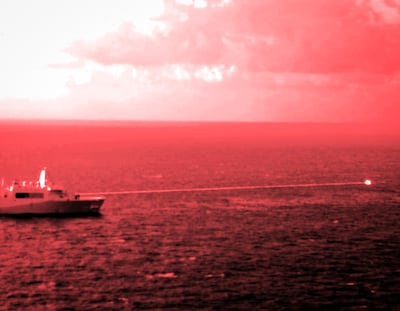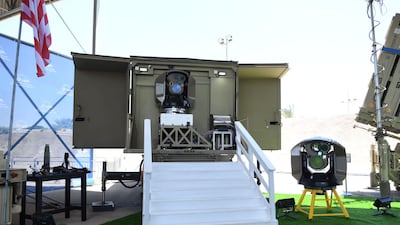Israel has said it will deploy its Iron Beam this year, potentially beating most countries in fielding a high-powered laser defence system.
Behind the claims – one analyst called it a “watershed” moment – there are important limitations of laser systems that could delay their widespread use.
To illustrate how difficult it has been to turn a laser design into something that can be brought on to the battlefield, Iron Beam was announced by manufacturer Rafael at a defence show in Singapore in 2014.
Eleven years later, the Israelis are optimistic it is finally ready and a promotional video shows it cutting through the wing of a target drone, a powerful 100-kilowatt beam with a up to 7km range in ideal conditions.
Laser defences, particularly against drones, have long been sought in light of recent conflicts in which swarms of relatively cheap explosive unmanned aircraft attack ships, energy infrastructure and towns.
The problem is that for larger drones, which fly low under radar – often undetected until the last minute or only seconds before impact – the most accurate and quickest way to hit them is with a missile. But this means it can cost several million dollars to hit a system costing tens of thousands of dollars.
Recent improvements in interceptor costs, with new systems such as the US Vampire, have brought that down to about $30,000 but it’s still not seen as ideal when armies plan to field thousands of drones.
Guns are effective but not fail-safe, and come with the risk of filling the sky with bullets and explosive shells, which at some point return to Earth, possibly killing civilians or friendly forces.
The Counter-Rocket, Artillery and Mortar (C-Ram) system fires shells that explode if they fail to hit the target, but they cost more than $80 each and at 4,500 rounds per minute, it adds up, including for the Phalanx naval version.
The Houthis' Red Sea blockade, Hamas’s massive rocket salvos and Hezbollah’s drone and rocket attacks on Israel are merely a few examples of conflict where this problem has arisen, as is the Ukraine war, where Kyiv has expended billions of military aid shooting down cheap Geran drones, a weapon based on Iran’s Shahed 136.
The US burnt through nearly $2 billion in missiles in 15 months to intercept Houthi drones and (more expensive) Houthi cruise missiles and anti-ship missiles. Interceptor stocks are seen by analysts as very hard to replace, with long lead times on orders for more missiles, and while the Houthi systems intercepted were cheaper, US and allied naval forces in the Red Sea often had no choice but to use costly systems to hit them or risk taking a lethal hit to their ships.
Cheap drones have also been used in attacks on American soldiers in Iraq, Syria, and Jordan, as well as US allies, and have caused serious damage to energy infrastructure in Saudi Arabia at the hands of the Houthis during Yemen’s civil war. Even with Israel’s relatively inexpensive Iron Dome system, which has shot down thousands of rockets and drones, Tamir interceptor stockpiles have drained away.
Lasers promise to change the cost calculation for manufacturers of laser defence systems, such as Britain’s DragonFire or the Iron Beam, who often claim the weapons can stop targets for a few dollars a shot. This, one industry expert said, was difficult to verify because of the huge cost in developing the systems and uncertainty surrounding how they will be maintained. One estimate puts the cost of Iron Beam at up to $1,000 a shot.
It is therefore easy to see why Iron Beam could be a landmark. The US spent 16 years trying to develop an airborne laser that could shoot down ballistic missiles before cancelling the project – after $5 billion had been spent – in 2009.
Another project, the Airborne High Energy Laser, aimed to put a laser on a Hercules aircraft but was cancelled last year after a pile up of technical challenges. Seaborne lasers have been similarly troubled, with technical problems including beams losing power in moist air, requiring special "free-electron" lasers.
All lasers suffer the same challenge of bending due to changes in atmospheric conditions, such as air density over distance or dust, requiring complex "beam-control" systems to counter the distortion.
Ground-based lasers
Knocking down lightweight drones from a ground-based system is far more realistic but not without issues.
One expert working for a company testing an air defence laser recently told The National that the aim is to neutralise the threat, not destroy it. Even a powerful laser is unlikely to cause a drone to explode spectacularly, because the system needs to keep the beam on target for several seconds. The experts say the aim is to hit the drone’s optical sensors, which can be “blinded” by the laser.
Based on promotional video, Iron Beam could do considerably more damage than this and might be able to rapidly turn against rockets and mortars.
Even this comes with the challenge of what designers call “ruggedisation”, making high-tech and delicate electronic equipment durable enough to be mounted on a combat vehicle and driven over rough roads in dusty or wet environments. Here, the US has also struggled with its DE M-Shorad system, a 50-kilowatt laser mounted on the back of a Stryker armoured vehicle.
Last year, US Army equipment acquisition head Doug Bush said the DE M-Shorad – with half the power of Iron Beam – struggled to incorporate the laser on to “a vehicle that has to move around constantly – the heat dissipation, the amount of electronics, kind of the wear and tear of a vehicle in a tactical environment versus a fixed site”.
That is despite the US fielding the weapon in Iraq in the past few years, likely to be the first use of lasers in combat, although few details have been released beyond Mr Bush's remarks.
One industry professional recently told The National he believed that use of lasers against drones in Iraq proved the systems were combat ready but there have been reports of the systems requiring clean rooms – science lab-level conditions – for maintenance, not ideal in a dusty war zone.
If Iron Beam is successful – compared to attempted laser deployments on planes, ships and mobile vehicles – it might be because it will be used on fixed sites with nearby electricity to power the system and dedicated maintenance engineers.
The Israelis also say there is a 50-kil0watt version of Iron Beam for vehicles but it remains to be seen if they have overcome the challenges experienced by the US DE M-Shorad system.
The Israelis also say Iron Beam will be used in conjunction with Iron Dome, cutting down overall interceptor costs.
UAE currency: the story behind the money in your pockets
UAE currency: the story behind the money in your pockets
The specs
Engine: 2.0-litre four-cylinder turbo
Power: 178hp at 5,500rpm
Torque: 280Nm at 1,350-4,200rpm
Transmission: seven-speed dual-clutch auto
Price: from Dh209,000
On sale: now
The%20Genius%20of%20Their%20Age
%3Cp%3EAuthor%3A%20S%20Frederick%20Starr%3Cbr%3EPublisher%3A%20Oxford%20University%20Press%3Cbr%3EPages%3A%20290%3Cbr%3EAvailable%3A%20January%2024%3C%2Fp%3E%0A
More from Rashmee Roshan Lall
Killing of Qassem Suleimani
'Nightmare Alley'
Director:Guillermo del Toro
Stars:Bradley Cooper, Cate Blanchett, Rooney Mara
Rating: 3/5
UAE currency: the story behind the money in your pockets
Volunteers offer workers a lifeline
Community volunteers have swung into action delivering food packages and toiletries to the men.
When provisions are distributed, the men line up in long queues for packets of rice, flour, sugar, salt, pulses, milk, biscuits, shaving kits, soap and telecom cards.
Volunteers from St Mary’s Catholic Church said some workers came to the church to pray for their families and ask for assistance.
Boxes packed with essential food items were distributed to workers in the Dubai Investments Park and Ras Al Khaimah camps last week. Workers at the Sonapur camp asked for Dh1,600 towards their gas bill.
“Especially in this year of tolerance we consider ourselves privileged to be able to lend a helping hand to our needy brothers in the Actco camp," Father Lennie Connully, parish priest of St Mary’s.
Workers spoke of their helplessness, seeing children’s marriages cancelled because of lack of money going home. Others told of their misery of being unable to return home when a parent died.
“More than daily food, they are worried about not sending money home for their family,” said Kusum Dutta, a volunteer who works with the Indian consulate.
More on Quran memorisation:
Zidane's managerial achievements
La Liga: 2016/17
Spanish Super Cup: 2017
Uefa Champions League: 2015/16, 2016/17, 2017/18
Uefa Super Cup: 2016, 2017
Fifa Club World Cup: 2016, 2017
The%20specs
%3Cp%3E%3Cstrong%3EEngine%3A%20%3C%2Fstrong%3E4.0-litre%20twin-turbo%20V8%0D%3Cbr%3E%3Cstrong%3EPower%3A%20%3C%2Fstrong%3E640hp%20at%206%2C000rpm%0D%3Cbr%3E%3Cstrong%3ETorque%3A%20%3C%2Fstrong%3E850Nm%20from%202%2C300-4%2C500rpm%0D%3Cbr%3E%3Cstrong%3ETransmission%3A%20%3C%2Fstrong%3E8-speed%20auto%0D%3Cbr%3E%3Cstrong%3EFuel%20consumption%3A%20%3C%2Fstrong%3E11.9L%2F100km%0D%3Cbr%3E%3Cstrong%3EPrice%3A%20%3C%2Fstrong%3EDh749%2C800%0D%3Cbr%3E%3Cstrong%3EOn%20sale%3A%20%3C%2Fstrong%3Enow%3C%2Fp%3E%0A
The candidates
Dr Ayham Ammora, scientist and business executive
Ali Azeem, business leader
Tony Booth, professor of education
Lord Browne, former BP chief executive
Dr Mohamed El-Erian, economist
Professor Wyn Evans, astrophysicist
Dr Mark Mann, scientist
Gina MIller, anti-Brexit campaigner
Lord Smith, former Cabinet minister
Sandi Toksvig, broadcaster
North Pole stats
Distance covered: 160km
Temperature: -40°C
Weight of equipment: 45kg
Altitude (metres above sea level): 0
Terrain: Ice rock
South Pole stats
Distance covered: 130km
Temperature: -50°C
Weight of equipment: 50kg
Altitude (metres above sea level): 3,300
Terrain: Flat ice
The biog
Hobbies: Writing and running
Favourite sport: beach volleyball
Favourite holiday destinations: Turkey and Puerto Rico
The%20specs
%3Cp%3E%3Cstrong%3EEngine%3A%20%3C%2Fstrong%3E2.3-litre%20turbo%204-cyl%3Cbr%3E%3Cstrong%3ETransmission%3A%20%3C%2Fstrong%3E10-speed%20auto%3Cbr%3E%3Cstrong%3EPower%3A%20%3C%2Fstrong%3E298hp%3Cbr%3E%3Cstrong%3ETorque%3A%20%3C%2Fstrong%3E452Nm%3Cbr%3E%3Cstrong%3ETowing%20capacity%3A%20%3C%2Fstrong%3E3.4-tonne%3Cbr%3E%3Cstrong%3EPayload%3A%20%3C%2Fstrong%3E4WD%20%E2%80%93%20776kg%3B%20Rear-wheel%20drive%20819kg%3Cbr%3E%3Cstrong%3EPrice%3A%20%3C%2Fstrong%3EPrice%3A%20Dh138%2C945%20(XLT)%20Dh193%2C095%20(Wildtrak)%3Cbr%3E%3Cstrong%3EDelivery%3A%3C%2Fstrong%3E%20from%20August%3C%2Fp%3E%0A
Key figures in the life of the fort
Sheikh Dhiyab bin Isa (ruled 1761-1793) Built Qasr Al Hosn as a watchtower to guard over the only freshwater well on Abu Dhabi island.
Sheikh Shakhbut bin Dhiyab (ruled 1793-1816) Expanded the tower into a small fort and transferred his ruling place of residence from Liwa Oasis to the fort on the island.
Sheikh Tahnoon bin Shakhbut (ruled 1818-1833) Expanded Qasr Al Hosn further as Abu Dhabi grew from a small village of palm huts to a town of more than 5,000 inhabitants.
Sheikh Khalifa bin Shakhbut (ruled 1833-1845) Repaired and fortified the fort.
Sheikh Saeed bin Tahnoon (ruled 1845-1855) Turned Qasr Al Hosn into a strong two-storied structure.
Sheikh Zayed bin Khalifa (ruled 1855-1909) Expanded Qasr Al Hosn further to reflect the emirate's increasing prominence.
Sheikh Shakhbut bin Sultan (ruled 1928-1966) Renovated and enlarged Qasr Al Hosn, adding a decorative arch and two new villas.
Sheikh Zayed bin Sultan (ruled 1966-2004) Moved the royal residence to Al Manhal palace and kept his diwan at Qasr Al Hosn.
Sources: Jayanti Maitra, www.adach.ae
SPEC%20SHEET%3A%20APPLE%20M3%20MACBOOK%20AIR%20(13%22)
%3Cp%3E%3Cstrong%3EProcessor%3A%3C%2Fstrong%3E%20Apple%20M3%2C%208-core%20CPU%2C%20up%20to%2010-core%20CPU%2C%2016-core%20Neural%20Engine%3C%2Fp%3E%0A%3Cp%3E%3Cstrong%3EDisplay%3A%3C%2Fstrong%3E%2013.6-inch%20Liquid%20Retina%2C%202560%20x%201664%2C%20224ppi%2C%20500%20nits%2C%20True%20Tone%2C%20wide%20colour%3C%2Fp%3E%0A%3Cp%3E%3Cstrong%3EMemory%3A%3C%2Fstrong%3E%208%2F16%2F24GB%3C%2Fp%3E%0A%3Cp%3E%3Cstrong%3EStorage%3A%3C%2Fstrong%3E%20256%2F512GB%20%2F%201%2F2TB%3C%2Fp%3E%0A%3Cp%3E%3Cstrong%3EI%2FO%3A%3C%2Fstrong%3E%20Thunderbolt%203%2FUSB-4%20(2)%2C%203.5mm%20audio%2C%20Touch%20ID%3C%2Fp%3E%0A%3Cp%3E%3Cstrong%3EConnectivity%3A%3C%2Fstrong%3E%20Wi-Fi%206E%2C%20Bluetooth%205.3%3C%2Fp%3E%0A%3Cp%3E%3Cstrong%3EBattery%3A%3C%2Fstrong%3E%2052.6Wh%20lithium-polymer%2C%20up%20to%2018%20hours%2C%20MagSafe%20charging%3C%2Fp%3E%0A%3Cp%3E%3Cstrong%3ECamera%3A%3C%2Fstrong%3E%201080p%20FaceTime%20HD%3C%2Fp%3E%0A%3Cp%3E%3Cstrong%3EVideo%3A%3C%2Fstrong%3E%20Support%20for%20Apple%20ProRes%2C%20HDR%20with%20Dolby%20Vision%2C%20HDR10%3C%2Fp%3E%0A%3Cp%3E%3Cstrong%3EAudio%3A%3C%2Fstrong%3E%204-speaker%20system%2C%20wide%20stereo%2C%20support%20for%20Dolby%20Atmos%2C%20Spatial%20Audio%20and%20dynamic%20head%20tracking%20(with%20AirPods)%3C%2Fp%3E%0A%3Cp%3E%3Cstrong%3EColours%3A%3C%2Fstrong%3E%20Midnight%2C%20silver%2C%20space%20grey%2C%20starlight%3C%2Fp%3E%0A%3Cp%3E%3Cstrong%3EIn%20the%20box%3A%3C%2Fstrong%3E%20MacBook%20Air%2C%2030W%2F35W%20dual-port%2F70w%20power%20adapter%2C%20USB-C-to-MagSafe%20cable%2C%202%20Apple%20stickers%3C%2Fp%3E%0A%3Cp%3E%3Cstrong%3EPrice%3A%3C%2Fstrong%3E%20From%20Dh4%2C599%3C%2Fp%3E%0A
Manchester City transfers:
OUTS
Pablo Zabaleta, Bacary Sagna, Gael Clichy, Willy Caballero and Jesus Navas (all released)
INS
Ederson (Benfica) £34.7m, Bernardo Silva (Monaco) £43m
ON THEIR WAY OUT?
Joe Hart, Eliaquim Mangala, Samir Nasri, Wilfried Bony, Fabian Delph, Nolito and Kelechi Iheanacho
ON THEIR WAY IN?
Dani Alves (Juventus), Alexis Sanchez (Arsenal)
Tips for used car buyers
- Choose cars with GCC specifications
- Get a service history for cars less than five years old
- Don’t go cheap on the inspection
- Check for oil leaks
- Do a Google search on the standard problems for your car model
- Do your due diligence. Get a transfer of ownership done at an official RTA centre
- Check the vehicle’s condition. You don’t want to buy a car that’s a good deal but ends up costing you Dh10,000 in repairs every month
- Validate warranty and service contracts with the relevant agency and and make sure they are valid when ownership is transferred
- If you are planning to sell the car soon, buy one with a good resale value. The two most popular cars in the UAE are black or white in colour and other colours are harder to sell
Tarek Kabrit, chief executive of Seez, and Imad Hammad, chief executive and co-founder of CarSwitch.com




